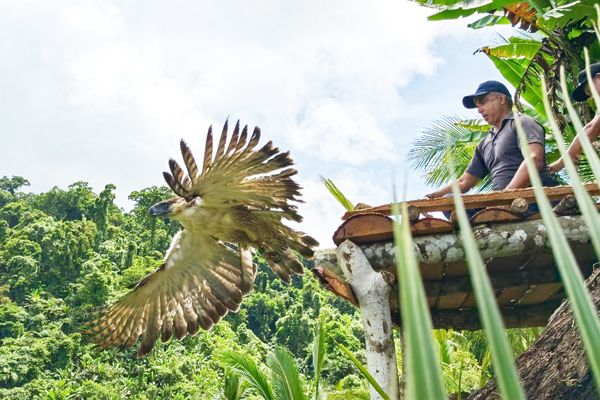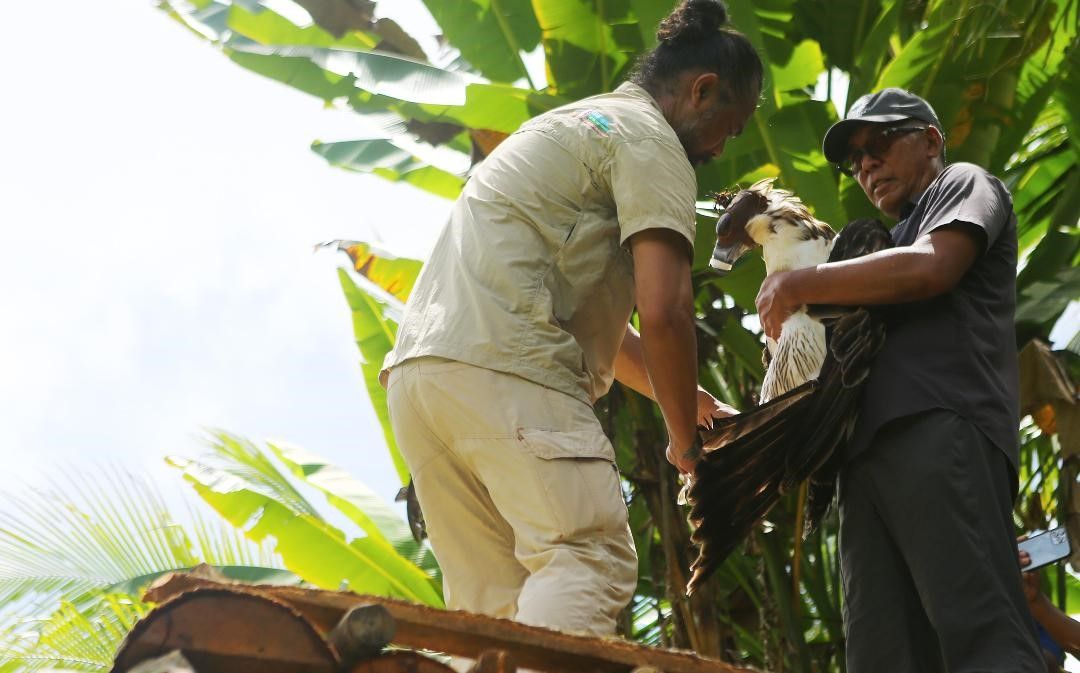BURAUEN, Leyte – We shall return.
Just like the iconic mantra of Gen. Douglas MacArthur when he returned to liberate the Philippines from Japanese occupation in World War II, a pair of Philippine Eagles made a return to the forests of Anonang-Lobi Range Key Biodiversity Area on Friday, June 28.

PHILIPPINE Eagle ‘Carlito’ soars over Barangay Kagbana, Burauen, Leyte. (Keith Bacongco)
The reintroduction of these eagles signifies a bold step for the conservation efforts of this critically ndangered avian, whose population here was believed to have been wiped out during the
onslaught of super typhoon “Yolanda” (international name “Haiyan”) in 2013.
Dr. Jayson Ibañez, Director of Operations of the Davao City-based Philippine Eagle Foundation, said the reintroduction of Philippine Eagles is a significant milestone in the group’s conservation program.
Ibañez added that the pair of eagles were translocated from Mindanao for acclimatization to the host community of Barangay Kagbana here last June 11.
This was also the first time that the PEF translocated the eagles named “Uswag” and “Carlito” from Mindanao to Visayas.
Both eagles who were rescued from the wild after they were wounded by air guns. They underwent rehabilitation at the Philippine Eagle Center in Malagos in Davao City prior to its translocation here on June 11.
The pair of eagles were equipped with global positioning system (GPS) transmitters to follow their movements. As the raptors are equipped with GPS transmitters, Ibañez said they can get ahead of their path and conduct extensive information campaigns to alert locals and authorities about their presence.
But the PEF official admitted that future super typhoons can also be a threat. “But by releasing as many fit and healthy birds as possible, we can ensure that the strong and healthy individuals would be resilient to typhoons and future natural calamities.”
Their release was graced by Department of Environment and Natural Resources Secretary Maria Antonia Yulo-Loyzaga, PEF funding partners, local government officials, and residents.
20 years apart
Their release came 20 years later after what was supposed to be the first milestone in the conservation efforts of the PEF.
In April 22, 2004, the PEF took a bold step when it released captive-bred eagle named “Kabayan” into the forests inside the Philippine National Oil Company-Energy Development Corp. (PNOC-EDC) on the slopes of Mount Apo in Kidapawan City, North Cotabato.
It was the first ever attempt by the PEF to release a captive-bred eagle to the wild.
However, nine months later, Kabayan reportedly died due to electrocution inside the PNOC-EDC forest reserves after he perched on power lines.
Kabayan was named after its adopter then Vice President Noli de Castro. The Vice President also sponsored the eagle’s food while in captivity and its care expenses. He also shouldered the cost of its release, two years after it hatched in 2002.

DR. Munir Virani of the Mohamed Bin Zayed Raptor Conservation Fund releases Philippine Eagle ‘Uswag’ in Barangay Kagbana, Burauen, Leyte on Friday, June 28. (Keith Bacongco)
Why Burauen?
Ibañez said that two sites were considered for the translocation of the eagles – the Mount Nacolod Key Biodiversity Area in Southern Leyte and Anonang-Lobi Range Key Biodiversity Area. These two areas had historical records of Philippine Eagles.
“However, out of the two, the Anonang-Lobi KBA had more prey diversity and prey numbers. We also had more stakeholder partners in Leyte compared to Southern Leyte, and the presence of the Energy Development Corp. managing the Anonang Lobi KBA as a geothermal reservation boosted the suitability of the area as a pilot release site,” he said.
The seasoned conservationist pointed out that Barangay Kagbana here was chosen as the host community because it is the only gateway to the whole Marabong Watershed.
Ibañez said the 58,000-hectare key biodiversity area can accommodate between six to eight pairs of Philippine Eagles.
A pair of eagles need at least 4,000 to 11, 000 hectares of forests to survive, PEF said.
The community has the monopoly and control of the whole watershed being the only barangay that is immediately at the mouth of the watershed, Ibañez added.
“We believe that if we can get the help and support of Kagbana, then we can effectively ensure the safety of the released eagles and their hunting habitat.”
From hunters to forest guards
The PEF admitted that the among the main challenge in translocating the eagles to Leyte is wildlife hunting within the Marabong watershed area. They resolved this through a community-based project that they installed in 2013 as well as instilling conservation values to the host community of Barangay Kagbana.
Ibañez added that the PEF trained and hired hunters as guardians of the watershed, adding that regular foot patrols and wildlife monitoring have slowly replaced wildlife hunting as their supplemental source of income.
“If research and eagle monitoring becomes a regular thing at Kagbana and Marabong watershed, we expect a total buy-in for conservation among all locals in the community.”
Barangay Kagbana Captain Rodolfo Ecija assured the safety of the eagles, saying that they will keep the raptors safe for as long as they are in the barangay forest.
Ecija also appealed to other barangay officials and residents to help safeguarding the eagles.

PHILIPPINE Eagle Foundation Executive Director Dennis Salvador and animal keeper Dominic Tadena prepare to release Philippine Eagle ‘Carlito.’ (Keith Bacongco)
Barangay Kagbana Kagawad or Councilor Rogelio Gloria said that they are glad to be chosen as the host community of the country’s national bird.
Gloria, a former long-time barangay chairman, added that they have prepared to ensure the reintroduction of the Philippine Eagles in their forests.
In the past, he said, the barangay had been home to wildlife hunters. The forest of Kagbana, he said, is a known home of wild boars, wild deer, and other wild animals.
“Historically, many of the residents used to hunt in the wild for living. According to our elders, Kagbana used to be a hunting ground, it is used to be a place where hunters from other places would temporarily camp when they were out to hunt. Until such time it became a permanent home to some of the hunters.”
Ibañez said they have trained at least 20 community members to become forest guards who are equipped to monitor and ensure the safety of the eagles and keep them safe. “They will do shifts and take turns doing forest patrolling and eagle monitoring.”
Repopulation in Leyte
The release was just an initial step in the PEF’s bold plan to repopulate the forests of Leyte with Philippine Eagles in the next five years, according to Ibañez.
He disclosed that the PEF hopes to release a total of 18 birds within the next five years to reestablish at least six eagle pairs. “Some birds will naturally die, and so it's intentional that we are releasing more birds to account for natural mortalities due to sickness or other natural causes.”
The release of the eagles, he said, will level up their conservation for two reasons.
“By transferring eagles from Mindanao to safe and vacant habitats in Leyte, we are increasing the survival chances of the translocated eagles.”
The PEF said that there are about 400 pairs of eagles in the wild.
Ibañez said the eagles that will be translocated are surplus birds, which are young with no territories yet and vulnerable to shooting and hunting in some Mindanao forests.
“Instead of letting them die needlessly, we can save them and give them the opportunity to sexually mature and contribute new offspring to the dwindling population.”
The second reason, Ibañez said, is by securing surplus eagles from different eagle bloodlines of Mindanao, the PEF is enhancing genetic diversity of the population by giving opportunities for unrelated eagles to pair up and produce offspring from diverse backgrounds.
“The science of population genetics shows that mixing bloodlines is good for long-term survival of populations. Due to shrinking of forest habitats, the opportunity for eagles dispersing to new territories and new areas are limited.”